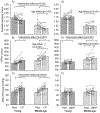Impact of acute changes in blood pressure and arterial stiffness on cerebral pulsatile haemodynamics in young and middle-aged adults
- PMID: 33938052
- PMCID: PMC8665418
- DOI: 10.1113/EP089319
Impact of acute changes in blood pressure and arterial stiffness on cerebral pulsatile haemodynamics in young and middle-aged adults
Abstract
New findings: What is the central question of this study? Does cerebrovascular pulsatility respond differently to acute increases in arterial stiffness in middle-aged compared with young adults? What is the main finding and its importance? Compared with young adults, middle-aged adults exhibited similar changes in cerebral pulsatile damping despite attenuated changes in carotid diameter and cerebrovascular pulsatility during blood pressure-dependent, but not blood pressure-independent, increases in large artery stiffness.
Abstract: Acute manipulation of arterial stiffness through interventions that increase sympathetic activity might provoke cerebral pulsatility and damping and reveal whether cerebrovascular haemodynamics respond differently to transient elevations in arterial stiffness in middle-aged compared with young adults. We compared cerebral pulsatility and damping in middle-aged versus young adults during two different sympathetic interventions [cold pressor test (CP) and lower-body negative pressure (LBNP)] that increase arterial stiffness acutely. Cerebrovascular haemodynamics were assessed in 15 middle-aged (54 ± 7 years old; 11 female) and 15 sex-matched young adults (25 ± 4 years old) at rest and during the CP test (4 min, 6.4 ± 0.8°C) and LBNP (6 min, -20 mmHg). Mean blood pressure was measured continuously via finger photoplethysmography. Carotid-femoral pulse wave velocity (cfPWV) and carotid stiffness were measured via tonometry and ultrasound. Blood velocity pulsatility index (PI) was measured at the middle cerebral (MCA) and common carotid artery (CCA) using Doppler, with pulsatile damping calculated as CCA PI divided by MCA PI. Increases in cfPWV were driven by changes in mean pressure during CP but not during LBNP in both groups (P < 0.05). Pulsatile damping decreased in both groups (P < 0.05) despite reductions in MCA PI and greater carotid dilatation during CP in young compared with middle-aged adults (P < 0.05). Pressure-independent increases in cfPWV during LBNP did not alter pulsatile damping but decreased MCA PI in both young and middle-aged adults (P < 0.05). These data suggest that changes in carotid diameter and cerebrovascular pulsatility differ between young and middle-aged adults despite similar changes in cerebral pulsatile damping during blood pressure-dependent, but not blood pressure-independent, increases in large artery stiffness.
Keywords: arterial stiffness; cerebral haemodynamics; pulsatility.
© 2021 The Authors. Experimental Physiology published by John Wiley & Sons Ltd on behalf of The Physiological Society.
Conflict of interest statement
We have no conflicts of interest to disclose.
Figures


Similar articles
-
Influence of sex and presence of cardiovascular risk factors on relations between cardiorespiratory fitness and cerebrovascular hemodynamics.J Appl Physiol (1985). 2022 Oct 1;133(4):1019-1030. doi: 10.1152/japplphysiol.00371.2022. Epub 2022 Sep 8. J Appl Physiol (1985). 2022. PMID: 36074924 Free PMC article.
-
Increased cerebral arterial pulsatility in patients with leukoaraiosis: arterial stiffness enhances transmission of aortic pulsatility.Stroke. 2012 Oct;43(10):2631-6. doi: 10.1161/STROKEAHA.112.655837. Epub 2012 Aug 23. Stroke. 2012. PMID: 22923446
-
Effects of acute aerobic exercise on arterial stiffness and cerebrovascular pulsatility in adults with and without hypertension.J Hypertens. 2018 Aug;36(8):1743-1752. doi: 10.1097/HJH.0000000000001752. J Hypertens. 2018. PMID: 29677054
-
Cerebral Haemodynamics: Effects of Systemic Arterial Pulsatile Function and Hypertension.Curr Hypertens Rep. 2018 Mar 19;20(3):20. doi: 10.1007/s11906-018-0822-x. Curr Hypertens Rep. 2018. PMID: 29556793 Review.
-
Impact of arterial stiffness on cerebrovascular function: a review of evidence from humans and preclincal models.Am J Physiol Heart Circ Physiol. 2024 Mar 1;326(3):H689-H704. doi: 10.1152/ajpheart.00592.2023. Epub 2024 Jan 12. Am J Physiol Heart Circ Physiol. 2024. PMID: 38214904 Free PMC article. Review.
Cited by
-
Efficacy of acupuncture in patients with carotid atherosclerosis: a randomized controlled clinical trial.BMC Complement Med Ther. 2024 Aug 22;24(1):313. doi: 10.1186/s12906-024-04601-3. BMC Complement Med Ther. 2024. PMID: 39174985 Free PMC article. Clinical Trial.
-
Effects of aerobic exercise training on cerebral pulsatile hemodynamics in middle-aged adults with elevated blood pressure/stage 1 hypertension.J Appl Physiol (1985). 2024 Jun 1;136(6):1376-1387. doi: 10.1152/japplphysiol.00689.2023. Epub 2024 Apr 11. J Appl Physiol (1985). 2024. PMID: 38601998 Free PMC article.
-
Regional cerebral pulsatile hemodynamics during isocapnic and poikilocapnic hyperthermia in young men.Physiol Rep. 2025 Feb;13(4):e70258. doi: 10.14814/phy2.70258. Physiol Rep. 2025. PMID: 39988809 Free PMC article.
-
Influence of sex and presence of cardiovascular risk factors on relations between cardiorespiratory fitness and cerebrovascular hemodynamics.J Appl Physiol (1985). 2022 Oct 1;133(4):1019-1030. doi: 10.1152/japplphysiol.00371.2022. Epub 2022 Sep 8. J Appl Physiol (1985). 2022. PMID: 36074924 Free PMC article.
-
Photoplethysmography for the Assessment of Arterial Stiffness.Sensors (Basel). 2023 Dec 17;23(24):9882. doi: 10.3390/s23249882. Sensors (Basel). 2023. PMID: 38139728 Free PMC article. Review.
References
-
- Bleasdale RA, Mumford CE, Campbell RI, Fraser AG, Jones CJ & Frenneaux MP (2003). Wave intensity analysis from the common carotid artery: a new noninvasive index of cerebral vasomotor tone. Heart Vessels 18, 202–206. - PubMed
-
- Bock JM, Hughes WE & Casey DP (2019). Age-Associated Differences in Central Artery Responsiveness to Sympathoexcitatory Stimuli. Am J Hypertens 32, 564–569. - PubMed
-
- Chiesa ST, Masi S, Shipley MJ, Ellins EA, Fraser AG, Hughes AD, Patel RS, Khir AW, Halcox JP, Singh-Manoux A, Kivimaki M, Celermajer DS & Deanfield JE (2019). Carotid artery wave intensity in mid- to late-life predicts cognitive decline: the Whitehall II study. Eur Heart J 40, 2300–2309. - PMC - PubMed
-
- Cui J, Wilson TE & Crandall CG (2002). Baroreflex modulation of muscle sympathetic nerve activity during cold pressor test in humans. Am J Physiol Heart Circ Physiol 282, H1717–1723. - PubMed
-
- de Riva N, Budohoski KP, Smielewski P, Kasprowicz M, Zweifel C, Steiner LA, Reinhard M, Fábregas N, Pickard JD & Czosnyka M (2012). Transcranial Doppler pulsatility index: what it is and what it isn’t. Neurocrit Care 17, 58–66. - PubMed
Publication types
MeSH terms
Grants and funding
LinkOut - more resources
Full Text Sources
Other Literature Sources
Research Materials
Miscellaneous

